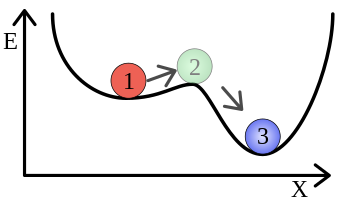Proper movement (control engineering)
Own movement or free movement referred to in the control engineering the movement that a system performs only by its initial displacement of the state without energization from the outside. They can be used to make a statement about the stability of a system.
Statement about the stability through the proper movement
In the case of linear systems , the following statements, once proven, apply globally, since the system properties do not depend on the states x. In the case of non-linear systems, the global verification of these properties is more difficult, but they can be used to make a local statement about the stability.
A system
-
- , the proper movement subsides and the system goes asymptotically into retirement ( asymptotically stable ) in linear systems .
- , the system remains in its initial state
- the proper movement sounds, that means an exponential growth over all boundaries in linear systems.
In the case of linear multi-variable systems in the state space representation , this property can be demonstrated using the real parts of the eigenvalues . The following applies:
- If all are the system is stable.
- If all are the system is at the limit of stability.
- If at least one is the system is unstable.
A nonlinear system can also be metastable ; H. the system can be stable in a certain area, but then from a certain state it can become unstable or move to another point of rest. Therefore, a more complex analysis, for example using the Lyapunov function , is necessary to prove the global asymptotic stability in nonlinear systems . When analyzing the Lyapunov function, the energetic state of a system is considered. If the energy of an autonomous system is steadily decreasing, this must also apply to the state variables. So it is based on a similar principle, see also stability theory .
Forced movement
During the forced movement, the reaction of the system to an input signal u (t) is checked. Typical input signals are the step function or periodic signals.
The reaction is made up of the additive and the forced movement.
The following applies to the step function:
For this function, a tank system with no outflow (integral behavior) is unstable, but a motor, for example, is stable because it has no integral behavior. The following cases can be distinguished:
- The system asymptotically approaches the final value.
- The system grows across all borders.
This investigation is particularly important in metastable systems, i.e. non-linear systems, since greater dependencies on the input variable can then arise.
In addition, the forced movement is very often used to characterize systems.
See also
Interesting here is the natural frequency that the frequency with which an oscillatable system can oscillate after a single excitation (if the damping is neglected )
literature
- Jan Lunze: Control Engineering Vol. 1 . Springer Verlag, 2005, ISBN 3-540-28326-9 .
- Jan Lunze: Control Engineering Vol. 2 . Springer Verlag, 2006, ISBN 3-540-32335-X .











